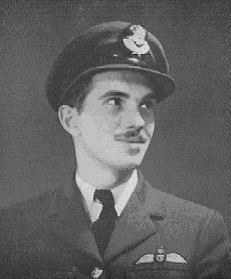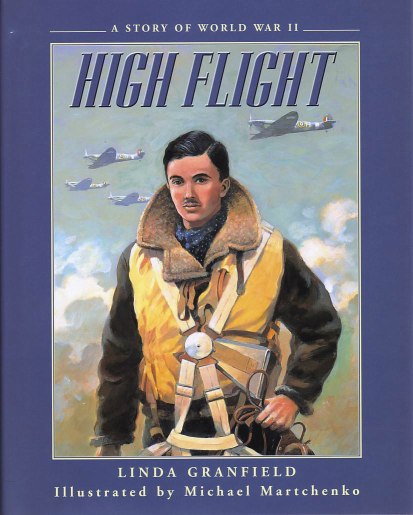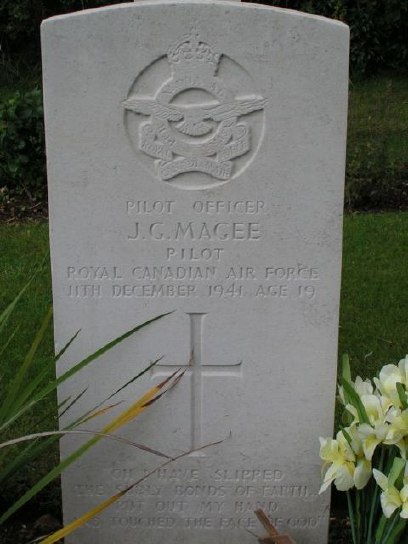 Museum
Museum  |
Bomber Command
|
Aircrew Chronicles
|
Aircrew Losses
|
Nose Art
|
BCATP
|
Lancaster
|
Media
|
Bomber Command
|
Aircrew Chronicles
|
Aircrew Losses
|
Nose Art
|
BCATP
|
Lancaster
|
Media
 Museum
Museum  |
Bomber Command
|
Aircrew Chronicles
|
Aircrew Losses
|
Nose Art
|
BCATP
|
Lancaster
|
Media
|
Bomber Command
|
Aircrew Chronicles
|
Aircrew Losses
|
Nose Art
|
BCATP
|
Lancaster
|
Media
Bomber Command Museum Chronicles
 |
Oh! I have slipped the surly bonds of Earth And danced the skies on laughter-silvered wings; Sunward I've climbed, and joined the tumbling mirth Of sun-split clouds, - and done a hundred things You have not dreamed of - wheeled and soared and swung High in the sunlit silence. Hov'ring there, I've chased the shouting wind along, and flung My eager craft through footless halls of air.... Up, up the long, delirious, burning blue I've topped the wind-swept heights with easy grace Where never lark, nor even eagle flew - And, while with silent, lifting mind I've trod The high untrespassed sanctity of space, Put out my hand, and touched the face of God. |
|
John Gillespie Magee Jr. was an American pilot and poet. He was born in Shanghai, China in 1922 to an American father and a British mother who worked as Anglican missionaries. John was educated at the American School in Nanking, China. In 1931 he moved with his mother to Britain where he continued his education at St. Clare's, Kent and then at Rugby School where he won the schools poetry prize in 1938. |
|
The following year he moved to the United States to live with his aunt. He completed his schooling in Connecticut, graduating with honours and earning a scholarship to Yale University where his father was then a chaplain. However, he chose not to enroll and, at the age of 18, enlisted in the Royal Canadian Air Force in October 1939. Like thousands of other young Americans, he was knowingly breaking the law but with the tacit approval of the then officially neutral U.S. government, he was volunteering to fight the Nazis.
He trained at Trenton, St. Catharines, and Uplands and received his wings in June 1941. His officers noted he was, "a very good pilot prospect" but, "lacks discipline" and was "somewhat overconfident." His friends remember liking him and that Magee thought he could do anything, laughed a lot, and made them laugh.
He was sent to England for operational training in Llandow, Wales. Later that year he was posted to No. 412 Fighter Squadron, RCAF, stationed at Digby, England. The squadron operated Supermarine Spitfire aircraft flying fighter sweeps over France and participating in air defence over England against the Luftwaffe.
On 3 September, 1941, Magee flew a high altitude (30,000 feet) test flight in a new Spitfire Mk V. During the flight he was struck with the inspiration for a poem -"To touch the face of God." In a letter to his parents he wrote, "I am enclosing a verse I wrote the other day. It started at 30,000 feet, and was finished soon after I landed." On the back of the letter he had written his poem, "High Flight."
Magee was killed just three months later at the age of 19 just three days after the U.S. entered the war. At an altitude of about 400 feet, his Spitfire (marked VZ-H) collided in clouds with an Oxford trainer flown by Ernest Aubrey Griffin. At the inquiry afterwards, a farmer testified that he saw the Spitfire pilot struggling to push back the canopy. The pilot stood up to jump from the plane but was too close to the ground for his parachute to open and died instantly. The Oxford pilot was killed in the accident as well.
In a letter to the Royal Canadian Air Force, John's parents wrote, "We gave our consent and blessing to John as he left us to enter the RCAF. We felt as deeply as he did and we were proud of his determination and spirit. We knew that such news as did come might come. When his sonnet (poem) reached us we felt then that it had a message for American youth but did not know how to get it before them. Now his death had emblazoned it across the entire country. We are thinking that this may have been a greater contribution than anything he may have done in he way of fighting. We will be forever proud of him." The original copy of the poem was soon on display at the Library of Congress in Washington where it remains today. Copies of a poster with the poem, a portrait of John, and a drawing of a Spitfire were sent to every airfield in the British Empire and newspapers printed the poem. "High Flight" is a wonderful book for young people written by Linda Granfield, impressively illustrated by Michael Martchenko, and highly regarded by the Magee family. Regarding the legacy of John Gillespie Magee, Linda wrote, "The poem is an anthem for all aviators: war veterans, commercial aircraft pilots, even glider pilots. 'High Flight' appeals to those who have soared in the clouds, and those who find consolation in a spiritual interpretation of the words." |
 |
Anyone who has ever flown an airplane is likely to be familiar with and value the poem High Flight, which was written in 1941 by my late brother, Pilot Officer John Gillespie Magee, Jr. The reason for this sonnet's durable popularity among pilots is that it has been found by many to give unique and felicitous expression to the emotions aroused by the act of piloting an aircraft.
Although this poem was inspired by the experience of flying a Spitfire over England during the period following the Battle of Britain, it has since become familiar to pilots everywhere, many of whom regard it as a kind of prayer. It has also been adopted by astronauts, notably the late Col. James Irwin, who served as lunar module pilot for the Apollo 15 mission. Irwin apparently took a copy of High Flight with him to the moon and was so affected by the mission and the poem's association with it that he later founded a religious organization called the High Flight Foundation.
Many astronauts, as well as members of the public at large, have been especially struck by the poem's opening and closing lines, which were quoted by President Reagan at the time of the Challenger disaster in 1986. Of the members of that ill-fated crew, the President said the following, "We will never forget them this morning as they prepared for their journey and waved goodbye and 'slipped the surly bonds of earth to touch the face of God.'" Not surprisingly, the poem was also referred to widely at the time of the Columbia disaster of 2003.
In fact, High Flight seems to have had a life of its own from the start. Soon after it was written, Archibald MacLeish, who served as Librarian of Congress from 1939 to 1944, identified the sonnet as the first great poem to come out of World War II, a view shared by the poet Joseph Auslander, then a poetry consultant to the Library of Congress. The poem was displayed in early 1942 in an exhibition of poetry at the Library entitled 'Faith and Freedom'. The manuscript copy of High Flight remains at the Library of Congress and High Flight has since appeared in many anthologies and books of quotations. At the end of the war, actor Tyrone Power, who had served as a U.S. Marine Corps fighter pilot, recited the poem from memory at a Hollywood gathering, in a moving tribute to all those who had given their lives. It was apparently on this occasion that fellow actor Ronald Reagan first heard the words of High Flight.
Lines from the sonnet have also appeared on many headstones in Arlington National Cemetery. In the period following the War, High Flight was used by many television stations as a close-down theme and over the years the poem has been set to music a number of times and numerous high school students have memorized it as part of their curriculum. The sonnet has likewise been featured in many films with parts of it being recited by such well-known actors as Russell Crowe and Mel Gibson. The poem's prominence continues to this day, as when the Presiding Bishop Elect of the Episcopal Church in the United States (herself a pilot) recently referred to it in a prime time news interview. So there is no doubt that High Flight is widely known, at least in the English-speaking world.
Since its authorship is also well established, one could make reasonable claim to the notion that my brother is somewhat famous, at least by name and association. Perhaps less well-known is the man behind the name, though there have been several biographies of John over the years.
John and I were the sons of missionary parents. Our mother, Faith Backhouse Magee, was English while our father, the Reverend John Gillespie Magee Sr., was American. Although I was born in London, John (who was 11 years older than I) was born in Shanghai in 1922. My next oldest living brother, David Backhouse Magee, was born in Kuling, China, in 1925. After preparation at an American school in China and a grammar school near the family home in England, John entered Rugby School, where he remained until 1939, the year he won the school's coveted poetry prize. Having travelled to the United States in 1939 on a family visit, he was unable to return to Britain for his final year at Rugby and therefore completed his schooling at the Avon School in the United States. While at Avon, at the age of 17, he published his first and only book of poems.
In 1940, John elected to join the Royal Canadian Air Force as an American volunteer and spent most of the following year training in Canada. After obtaining his wings in mid 1941, he was transferred to South Wales, via the Personnel Reception Centre at Bournemouth, for some final training. Shortly afterwards he was assigned to active service in the newly formed, No. 412 Fighter Squadron RCAF, based at Digby, Lincolnshire. While John was stationed at Digby, he was asked to test fly a newer model of the Spitfire V, which was capable of flying at an altitude of 30,000 feet. This experience evidently made such an impression on him that it provided the inspiration for his final poem, and best-known work, the sonnet High Flight. John was killed in a mid-air collision during practice maneuvers on December 13th 1941, just six days after the United States entered the War.
As John's sole heir, I have always felt a sense of having had something of a special relationship with him during the few years that we knew each other. Since he was away from home for much of that time, my memories of John are at best fleeting, though I recall enjoying a feeling of protection from him during minor family squabbles! Like both of my other brothers, I of course idolized him completely. There are, however, two distinct collections that I retain with great affection and both are associated in my mind with lines from High Flight.
The first had to do with John's willingness to connive with me in a little practical joke. As described in one of the biographies of John, during his last time with the family, while on final leave prior to embarkation to Britain in 1941, John, driving the enormous Packard convertible he had bought second-hand the previous summer, took the family into the lush countryside of Maryland and Virginia for occasional picnics. One of these outings found us making for a swimming pool made available for the occasion by the day camp in Maryland that I attended after school in those days. Having been to this secluded spot, I happened to know that there were some dips in the road that led to it and that, if traveling at a decent speed, those sitting in the back seat of a car were likely to get unexpectedly tossed into the air, an effect obviously heightened if the car happened to be a convertible! Shortly before we arrived at this stretch of road, I insisted that we stop and that the family be rearranged in such away as to provide the maximum airborne surprise to the maximum number of family members! John was certainly up for this joke and obligingly drove along the relevant stretch of road at maximum speed, so humoring his youngest brother and, no doubt, his own daredevil spirit!

|
The other episode that stands out in my mind is something I will never forget. The Packard, referred to above, was preceded by a more modest Ford V-8. At the time (the summer of 1940), the family had taken a holiday home in the town of Oak Bluffs on Martha's Vineyard, off the coast of Massachusetts. Mail had to be picked up every day from the main post office and, since our house was located on the outskirts one of John's daily tasks, as the only member of the family with a driver's license, was to retrieve the mail. On one such occasion John took me along. It was a precious time alone with him. On the way home, while driving along a coastal highway by the harbor (the road is still there) John suddenly pressed the accelerator to the floor so as to push the engine to its limit. Then, with totally uninhibited exuberance, he proceeded to shout at the top of his lungs! It was a thrilling, exhilarating moment for both of us. These two incidents, especially the latter episode, have always seemed to me to be reflective of that spirit of exaltation that one finds expressed in two lines of High Flight, "I've chased the shouting wind along, and flung my eager craft through footless falls of air." Be that as it may, my memories of John, though precious few, remain with me and I feel especially close to him to this day. |